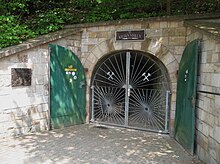Kilian tunnel
The Kilianstollen is a visitor mine in Marsberg ( Hochsauerlandkreis ). The visitor mine was set up in 1984 in a disused copper mine.
History of Marsberg copper mining

The mining went into the region Marsberg since at least the 12th century on slate around and minerals. It reached its peak in the 19th century. One in 900 of the monastery Corvey lent mint money notes was that there probably mined since the late 8th century copper and used as coinage. 1150 awarded Conrad III. (HRR) at Wibald of Stablo the right in Eresberg to prospect for copper, gold, silver, lead and tin.
Up to the 16th century mainly near-surface copper ores ("back ores") were mined. The mining of ores at greater depths failed because of the inadequate dewatering . The few primitive shafts were regularly flooded during heavy rain and snowmelt, which largely led to the cessation of mining.
Civil engineering only began in 1650 after the establishment of trade unions . At the beginning of the 18th century, mining around Marsberg came to a standstill due to civil unrest and fuel shortages. Numerous attempts by the Prussian state to revive the mining industry usually failed after a short period of operation. The ore mining experienced an economic boom when in 1834 the "Stadtberger union" took over the mining and smelting operations. It was converted into an AG in 1872 and ran the mining business until its liquidation in 1930. Marsberg copper mining reached its first heyday in 1863 when around 200 miners extracted 48,830 t of ore. In 1912 the annual copper output could be increased to 52,793 t. Inflation , fluctuations in world market prices and the loss of capital in the late 1920s led to the cessation of mining. In 1935 mining and smelting operations were resumed with the help of government subsidies under the leadership of the United Deutsche Metallwerke AG . After the Second World War , the company finally ceased in 1945.
Pebble red problem
In the 1930s, a new smelting process called chlorinating roasting was used in Marsberg , which subsequently led to considerable environmental problems. To increase the ore yield, 8% sodium chloride was added to the raw ore . At higher firing temperatures, the chlorine reacts with the organic substance that is present in the sub-carbonic alum shale (around 2–10%). The resulting compounds belong to the group of chlorinated hydrocarbons , including the group of dioxin and furan compounds . The accumulated during the last years of operation Halden with Kieselrot were sold until the 1968th A total of around 400,000 t of this waste product was marketed as "slag". It was used on many West German sports fields. In 1991, measurements on sports grounds in Bremen revealed a high level of dioxin and furan pollution. The content of dioxins and furans exceeded the permissible limit values in some cases by ten thousand times.
Kilianstollen show mine
After a three-year clean-up and expansion phase, the show mine was reopened to the public in 1984 by the Marsberger Heimatbund. Guided tours take place regularly from April to October. In the Kilian tunnel, rocks from the Upper Devonian to Lower Carbons are completely exposed. In addition to an overview of the geology and copper mining in the Marsberg region, special attention is paid to the processing of the copper-containing solutions.
Marsberg healing cave
The Marsberg Heilstollen was opened in summer 2013 . At an air temperature of 10 ° C and a relative humidity of 98%, the air we breathe is almost free of dust and allergens . The Heilstollen lies a few meters in the Kilianstollen mine.
literature
- Felix Bieker, Klaus Lattek: Kilianstollen - mining and geology in Marsberg . Ed .: Marsberger Heimatbund eV Schulte, Marsberg 1992.
- Daniela Böddicker: The copper mining in Marsberg, mainly in the 19th and 20th centuries . Ed .: University of Münster. Münster 1993 (Mag.-Arb.).
- Rainer Slotta : The pits on the ore deposits of Stadtberge-Niedermarsberg . In: German mining museum Bochum (Hrsg.): Technical monuments in the Federal Republic of Germany . Part 4/1 (The metal ore mining). Bochum 1983, p. 667-681 .
Web links
- Kilianstollen visitor mine. Retrieved April 15, 2014 .
Individual evidence
- ^ Béatrice Austria: Copper ores . In: Geological Service NRW (Ed.): Explanations for sheet 4519 Marsberg . 2nd Edition. Krefeld 2008, ISBN 978-3-86029-156-6 , p. 150-153 .
Coordinates: 51 ° 27 ′ 12 ″ N , 8 ° 51 ′ 42 ″ E






